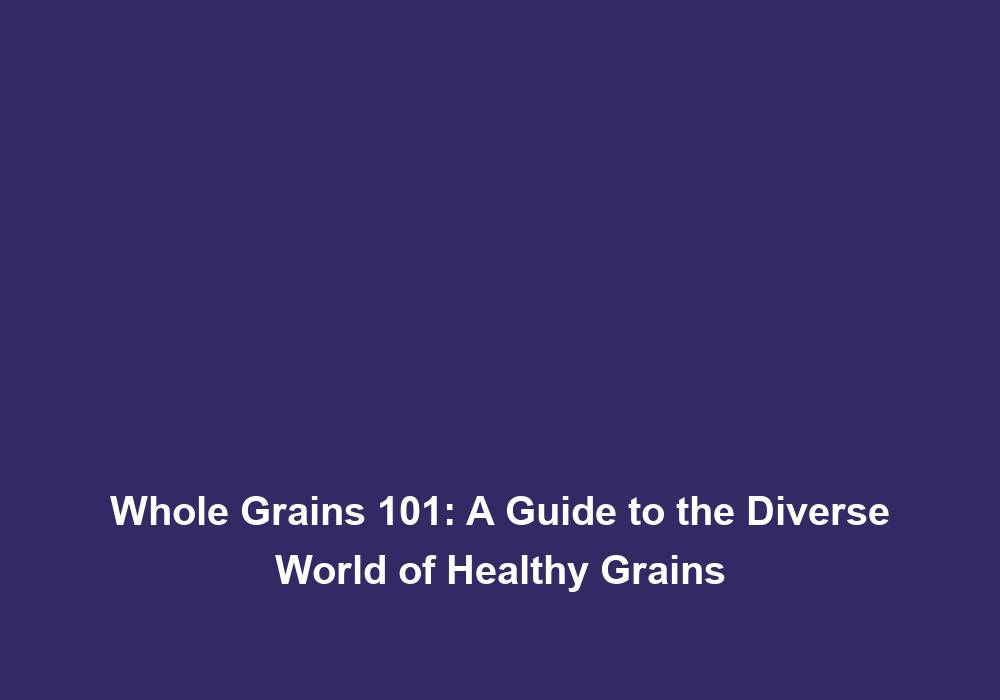Whole Grains 101: A Guide to the Diverse World of Healthy Grains
Whole grains are an essential part of a healthy diet, providing a wide range of nutrients, including fiber, vitamins, and minerals. In this comprehensive guide, we will explore the diverse world of healthy grains, delving into their nutritional benefits, different types, and how to incorporate them into your daily meals. So, let’s embark on this journey to discover the wonders of whole grains!
What are Whole Grains?
Whole grains are grains that contain all three parts of the grain kernel – the bran, germ, and endosperm. Unlike refined grains, which have had the bran and germ removed, whole grains retain their natural nutritional value and offer numerous health benefits.
The Nutritional Benefits of Whole Grains
Including whole grains in your diet can have several positive effects on your overall health. Here are some key nutritional benefits:
-
Fiber: Whole grains are an excellent source of dietary fiber, which aids in digestion, helps maintain a healthy weight, and reduces the risk of chronic diseases such as heart disease and diabetes. Fiber adds bulk to your diet, helping you feel fuller for longer and promoting regular bowel movements.
-
Vitamins and Minerals: Whole grains contain essential vitamins and minerals, including B vitamins, iron, magnesium, and selenium, which are crucial for maintaining optimal health and supporting various bodily functions. B vitamins play a vital role in energy production, iron is important for oxygen transport in the body, magnesium is involved in hundreds of enzymatic reactions, and selenium acts as an antioxidant.
-
Antioxidants: Many whole grains are rich in antioxidants, such as lignans and phenolic compounds, which help protect the body against inflammation and oxidative stress. Antioxidants neutralize harmful free radicals in the body, reducing the risk of chronic diseases and promoting overall well-being.
-
Phytochemicals: Some whole grains, like quinoa and buckwheat, contain phytochemicals that have been associated with a reduced risk of certain cancers and chronic diseases. Phytochemicals are natural compounds found in plants that have antioxidant and anti-inflammatory properties, offering additional health benefits beyond basic nutrition.
Now that we understand the nutritional benefits of whole grains, let’s explore the different types available.
Types of Whole Grains
There is a wide variety of whole grains to choose from, each with its unique taste and texture. Here are some popular types of whole grains:
1. Quinoa
Quinoa is a versatile grain that is packed with protein, fiber, and essential amino acids. It has a mild, nutty flavor and a slightly crunchy texture. Quinoa is gluten-free, making it an excellent choice for individuals with gluten sensitivity or celiac disease. It is also a complete protein, meaning it contains all nine essential amino acids that the body needs to function properly.
2. Brown Rice
Brown rice is a whole grain that retains its bran and germ layers, providing a good amount of fiber, vitamins, and minerals. It has a chewy texture and a slightly nutty taste. Brown rice is a healthier alternative to white rice and can be used in a variety of dishes, including stir-fries, salads, and pilafs. It is also rich in manganese, which plays a crucial role in metabolism and bone health.
3. Oats
Oats are a popular whole grain known for their high fiber content, particularly a type of fiber called beta-glucan, which has been linked to improved heart health. They can be enjoyed as oatmeal, added to baked goods, or used as a crunchy topping for yogurt or smoothie bowls. Oats are also a good source of plant-based protein and contain antioxidants called avenanthramides, which have anti-inflammatory properties.
4. Whole Wheat
Whole wheat is one of the most well-known whole grains and is commonly used in bread, pasta, and baked goods. It contains all three parts of the grain and provides a good source of fiber, B vitamins, and minerals. Opting for whole wheat products over refined alternatives is a simple way to incorporate whole grains into your diet. Whole wheat is also rich in phytochemicals, such as lignans and flavonoids, which have been associated with a reduced risk of heart disease and certain types of cancer.
5. Barley
Barley is a versatile grain that can be cooked in soups, stews, or used as a base for salads. It has a slightly chewy texture and a nutty taste. Barley is an excellent source of fiber and contains compounds called beta-glucans, which may help lower cholesterol levels and promote heart health. It is also a good source of selenium, a mineral that supports the immune system and has antioxidant properties.
6. Buckwheat
Despite its name, buckwheat is not related to wheat and is gluten-free. It is packed with nutrients such as magnesium, manganese, and fiber. Buckwheat is commonly used in the form of flour to make pancakes, noodles, and other baked goods. It is rich in flavonoids, which have been shown to have anti-inflammatory and antioxidant effects. Buckwheat also contains a unique type of soluble fiber called resistant starch, which has been linked to improved gut health.
7. Millet
Millet is a gluten-free grain that offers a good amount of fiber, protein, and essential minerals. It has a slightly sweet and nutty flavor and can be used as a side dish, in salads, or as a substitute for rice or couscous. Millet is particularly rich in magnesium, which plays a crucial role in nerve and muscle function, as well as bone health. It also contains antioxidants, such as phenolic compounds, which contribute to its overall health benefits.
Incorporating Whole Grains into Your Diet
Now that you have familiarized yourself with some of the different types of whole grains, let’s discuss how to incorporate them into your daily meals:
-
Breakfast: Start your day by adding oats to your breakfast routine. Enjoy a warm bowl of oatmeal topped with fresh fruits, nuts, and a drizzle of honey or maple syrup. You can also try whole grain cereal or toast with almond butter and sliced bananas.
-
Lunch: Swap refined grains with whole grains when preparing your favorite salads or grain bowls. Try using quinoa, brown rice, or barley as a nutritious base. Add in a variety of vegetables, lean proteins, and a flavorful dressing to create a satisfying and wholesome meal.
-
Snacks: Whole grain snacks can be a great way to satisfy hunger between meals. Grab a handful of air-popped popcorn, whole grain crackers, or make your own granola bars with oats and nuts. You can also enjoy whole grain bread with hummus or nut butter.
-
Dinner: Experiment with different whole grains in your dinner recipes. Substitute white rice or pasta with healthier alternatives like quinoa, whole wheat couscous, or buckwheat noodles. Incorporate whole grains into dishes such as stir-fries, grain-based salads, or stuffed bell peppers for added nutrition and flavor.
Remember to read labels carefully when purchasing packaged products and look for the term whole grain as one of the first ingredients listed. This ensures that you are getting the most nutritional benefits from your food choices.
Final Thoughts
Whole grains offer a diverse array of flavors, textures, and nutritional benefits. By incorporating a variety of whole grains into your diet, you can enhance the overall nutritional value of your meals and promote good health. Whether you choose quinoa, brown rice, oats, or any other whole grain, enjoy exploring the delicious possibilities and reap the rewards of a well-rounded diet. Start incorporating whole grains into your meals today and experience the positive impact on your health and well-being.







